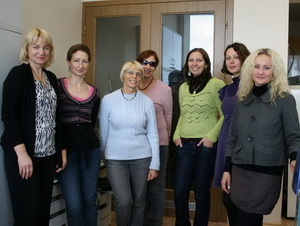Research overview
Much attention in our group is focused on studying possibilities of differentiation therapy by
determining new molecular mechanisms of cancer cell proliferation, differentiation and apoptosis using
in vitro system.
The human leukemia cell lines (HL-60, NB4, THP, K562, U937, etc.) and human cancer cells (HeLa) are used repeatedly as a model
to study the control mechanisms of cell proliferation, differentiation and apoptosis. The exponentially growing leukemia cells
can be induced to differentiate into granulocytes or monocytes by treatment with chemical agents. We are focusing ourselves
on drugs, i.e. differentiation inducers, histone deacetylase inhibitors, nucleoside analogues, etc. and their combinations
that could be potential for differentiation therapy of cancer cells.
As well as our goal is to identify proteins that might be involved in signalling events that mediate cancer cell differentiation.
Global proteomic analyses with MALDI-TOF MS and MS/MS techniques have let us to estimate the protein expressions and/or
modifications in normal and cancer cells.
Research areas
The main tasks are to investigate:
-
the effects of different novel HDAC inhibitors or its combination with other chemical agents on proliferation, differentiation and apoptosis of human cancer cells.
-
the mechanisms of action HDAC inhibitors that lead to differentiation and/or apoptosis of human cancer cells based on chromatin remodeling and histone acetylation.
-
protein-DNA interactions in a native chromatin environment.
-
proteins that associate with gene sequences in chromatin.
-
the possible role of alpha-dystrobrevin in proliferation and differentiation of human cancer cells.
-
the proteins that might be involved in signaling events mediating cell differentiation and for apoptosis in human leukemia and other cancer cell lines, cells isolated from patients and healthy human neutrophils.
-
protein localization in different cell compartments, possible their phosphorylation sites and role of phosphorylation in signal transduction.
Methods
-
Subcellular protein fractionation;
-
Electrophoretic mobility shift assay (EMSA);
-
Chromatin immunoprecipitation (ChIP) assay;
-
Global proteomic analysis including protein fractionation in 2DE system and mass spectrometry (MALDI-TOF MS, ESI-MS/MS) techniques;
-
Gene silencing (siRNA);
-
Protein visualization by video confocal and fluorescence microscopy.


